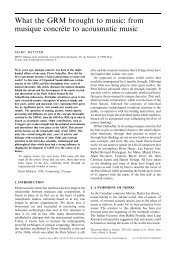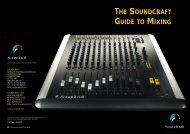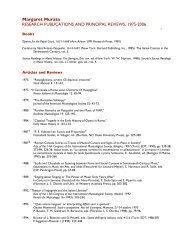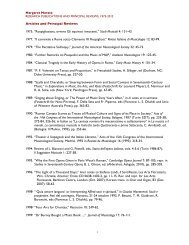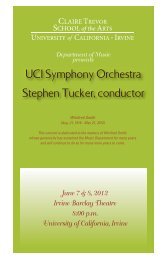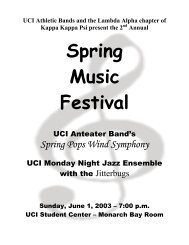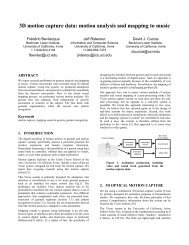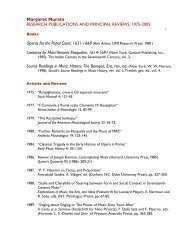âRoots and Branchesâ - Music - University of California, Irvine
âRoots and Branchesâ - Music - University of California, Irvine
âRoots and Branchesâ - Music - University of California, Irvine
Create successful ePaper yourself
Turn your PDF publications into a flip-book with our unique Google optimized e-Paper software.
Poster Presentations<br />
Friday, February 10, 2012<br />
12:30 PM Contemporary Arts Building<br />
Poster Presentations Coordinator: Dr. Maurice B. Wheeler<br />
Poser Presentations Facilitator: Dr. Jean Snyder<br />
Jennifer Odom Ciobanu<br />
<strong>University</strong> <strong>of</strong> North Texas<br />
“’The Wider View’: Engaging a New Generation <strong>of</strong> Singers through African-American Art Song”<br />
Through studying the poetry <strong>and</strong> its context, the lives <strong>of</strong> the poets <strong>and</strong> composers, <strong>and</strong> the musical choices which emerged from these combined<br />
influences, students <strong>of</strong> the “Millennial” generation may experience a deeper connection to art song <strong>and</strong> its role in defining <strong>and</strong> reflecting national character.<br />
Underst<strong>and</strong>ing the Millennials is central to maintaining vibrancy in the life <strong>of</strong> the voice studio, for this is where this generation studies the art form which<br />
they will in turn teach, perform, <strong>and</strong> pass on to future generations <strong>of</strong> students <strong>and</strong> audiences. In applying research on Millennials to the voice studio, one may<br />
conclude that there may be no better way to motivate young singers than to incorporate diverse <strong>and</strong> culturally-varied repertoire with which a student must<br />
engage through detailed study <strong>and</strong> performance. Not yet a part <strong>of</strong> the traditional canon <strong>of</strong> American art song, African-American art song is <strong>of</strong> particular<br />
value in this regard, <strong>of</strong>fering teachers, students, <strong>and</strong> recitalists less frequently-performed repertoire to explore. The unique lessons <strong>of</strong> African-American art<br />
song remain largely untapped <strong>and</strong> therefore <strong>of</strong>fer Millennials <strong>and</strong> those who teach them a niche for making a worthwhile contribution to the proliferation <strong>of</strong><br />
the genre. Many <strong>of</strong> these songs bring to light unique aspects <strong>of</strong> American culture <strong>and</strong> tradition—those <strong>of</strong> African-Americans-- thus enriching, educating,<br />
<strong>and</strong> ‘widening’ the experience <strong>of</strong> art song for audiences <strong>and</strong> performers.<br />
While much <strong>of</strong> African-American art song speaks to details <strong>of</strong> life <strong>and</strong> history <strong>of</strong> the black community, the specific circumstances <strong>of</strong> a poem<br />
<strong>of</strong>ten translate into a universal theme to which anyone may relate, helping bridge the gap between the seemingly different experiences among Americans <strong>of</strong><br />
diverse backgrounds. Representing a broad spectrum <strong>of</strong> literary <strong>and</strong> cultural influences, these songs are just as diverse, multi-faceted, <strong>and</strong> full <strong>of</strong> variety as<br />
any other body <strong>of</strong> art song repertoire <strong>and</strong> richly contribute to the past <strong>and</strong> present life <strong>of</strong> the genre. Going beyond the music <strong>and</strong> the words can only reinforce<br />
the study <strong>of</strong> technique <strong>and</strong> enrich the studio experience, while at the same time providing a multicultural learning environment which more accurately<br />
reflects the America in which these same students will become the singers <strong>and</strong> voice teachers <strong>of</strong> tomorrow.<br />
Brian K. Smith<br />
<strong>University</strong> <strong>of</strong> <strong>California</strong>, <strong>Irvine</strong><br />
“African Influence in the <strong>Music</strong> <strong>of</strong> Mexico’s Costa Chica Region”<br />
While European <strong>and</strong> Amerindian contributions to Mexican folk music traditions have been thoroughly acknowledged, the African influence has not been as<br />
widely publicized. However, ample evidence <strong>of</strong> African influence on folk music in Mexico exists, especially in the densely black-populated pueblos within<br />
the states <strong>of</strong> Guerrero <strong>and</strong> Oaxaca in the Costa Chica region. Instruments such as the marímbola (finger piano), quijada (jawbone), <strong>and</strong> tambor de fricción<br />
(friction drum) specifically point toward African influence in the folk music <strong>of</strong> Costa Chica. The main objective <strong>of</strong> this paper is to identify the African<br />
influence on the folk music in the region. By tracing the roots <strong>of</strong> certain instruments <strong>and</strong> folksongs that use these specific African instruments, this study<br />
seeks to address the underrepresentation <strong>of</strong> African influence in the Costa Chica region.<br />
Terrance L. Green<br />
<strong>University</strong> <strong>of</strong> Wisconsin-Madison<br />
“Ideological Contestation In Urban Spaces: The Leadership Practices <strong>of</strong> African American High School Principals<br />
During Pre-Brown That Can Inform Urban Leadership Preparation Programs”<br />
The purpose <strong>of</strong> this exploratory paper is to review the literature on African American high school principals <strong>and</strong> high-achieving all-Black high schools,<br />
during the pre-Brown era to consider how this literature can inform urban leadership preparation programs. To achieve this purpose, I address three<br />
questions: (a) What leadership practices did African American high school principals employ during legalized segregation that supported high academic<br />
achievement? (b) How has the socio-spatial context <strong>of</strong> Black high schools evolved during pre <strong>and</strong> post Brown? <strong>and</strong> (c) In what ways might the leadership<br />
<strong>and</strong> institutional practices <strong>of</strong> African American high school principals <strong>and</strong> high-achieving all-Black high schools, pre-Brown inform urban leadership<br />
preparation programs? To conceptually frame this paper, I draw on Sank<strong>of</strong>a—an African centered theoretical lens. The findings will advise future research<br />
<strong>and</strong> urban leadership preparation.



